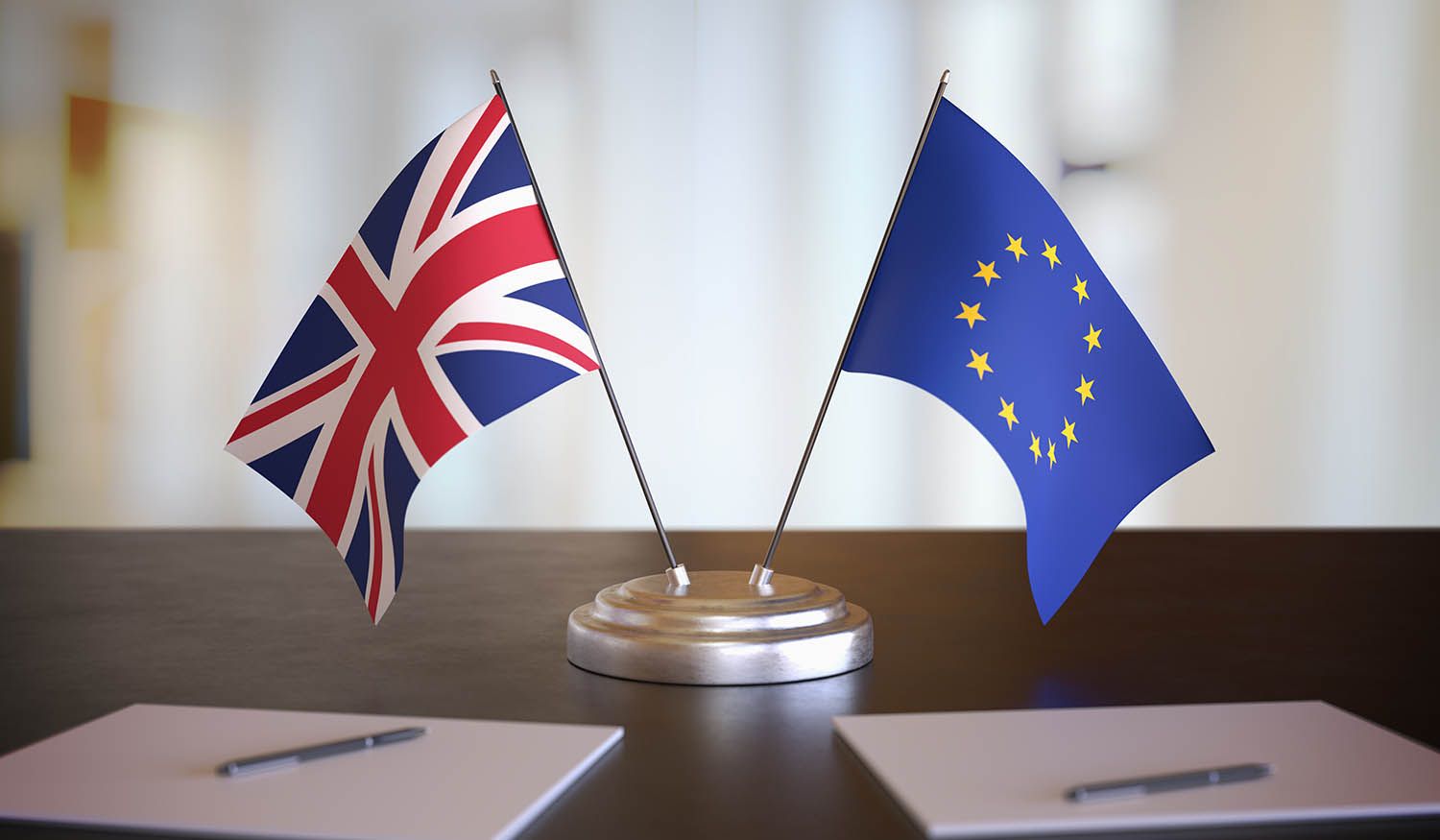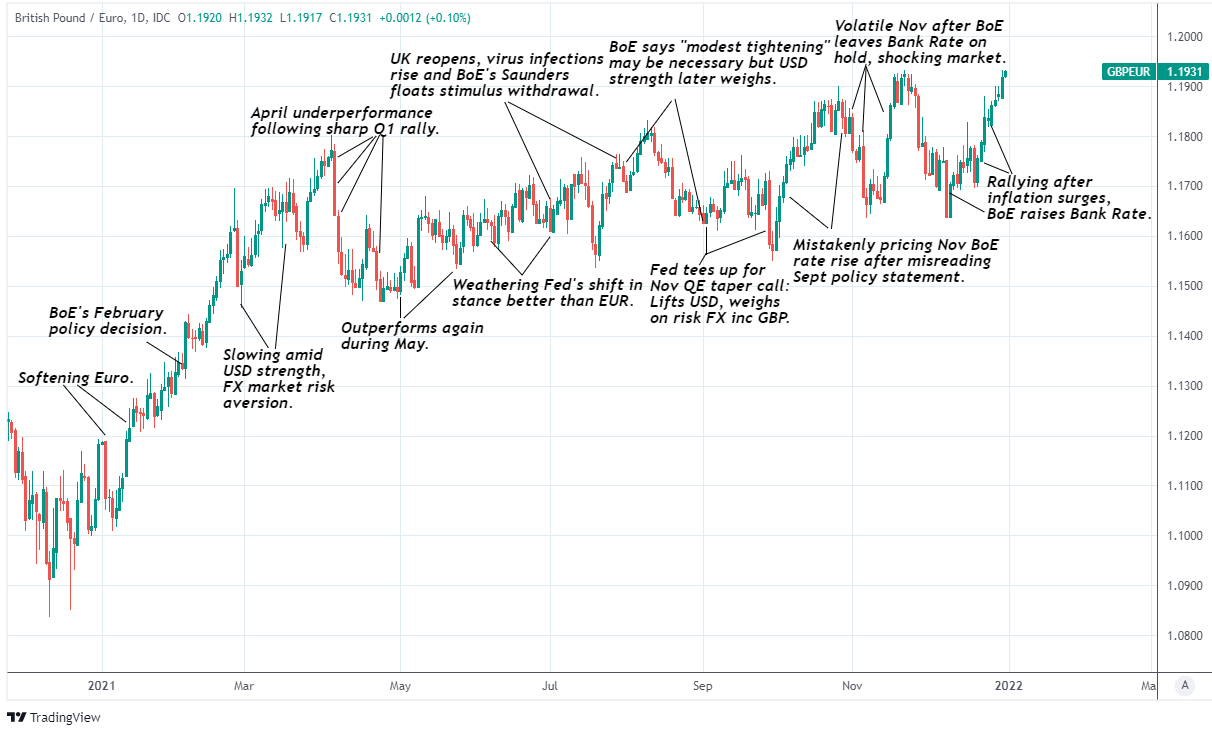Pound / Euro Rate Serenades Rollercoaster 2021 Recovery with New Highs
- Written by: James Skinner

Image © Adobe Images
The Pound to Euro exchange rate reached new highs for the year during the final day of trading, serenading along the way what has been a rollercoaster recovery that leaves it within a short distance of post-referendum highs as the curtain closes on 2021.
Pound Sterling edged above November’s 2021 high at 1.1931 on Friday following a volatile final quarter of the year, and leaving GBP/EUR within arm’s reach of post-referendum highs located a short distance above the nearby 1.20 handle.
This extended December rally lifted the Pound-Euro rate’s 2021 gain to 7.7% in the final hours of trading for the year, and came in a buoyant market for risk assets where major stock indices were higher and U.S. Dollar exchange rates were lower against all but the lowest yielding major currencies.
“It maintains a decent upward trend since the days following the BoE’s hike in mid-month,” says Shaun Osborne, chief FX strategist at Scotiabank.
“Markets are nevertheless still expecting four 25bps hikes by the BoE next year which should support the GBP against the likes of the EUR and JPY—though gains vs the USD look more limited with the Fed likely to tighten by a similar amount,” Osborne and colleagues said on Thursday.
GBP/EUR rose close to three percent from its December 08 lows near 1.1624, with the rally gaining traction from mid-month after Office for National Statistics (ONS) figures suggested employment went unaffected by September’s end of HM Treasury’s furlough scheme.
Above: GBP/EUR shown at daily intervals and annotated for 2021. Click image for closer inspection.
- Reference rates at publication:
GBP to EUR: 1.1943 - High street bank rates (indicative): 1.1625 - 1.1700
- Payment specialist rates (indicative: 1.1859 - 1.1883
- Find out more about specialist rates, here
- Set up an exchange rate alert, here
December 14’s labour market figures and the inflation data released by the ONS a day later, which showed the consumer price index surging above 5% for November, may well have catalysed the December 16 Bank of England (BoE) decision to lift Bank Rate from 0.1% to 0.25%.
“Doing this will help bring the rate of inflation down. It will take time to work. We expect the rate of inflation to reach around 6% in the spring. But increasing interest rates now will help make sure inflation falls back to our 2% target by the end of 2023,” the BoE says on its website.
That made the BoE the first within the G7 contingent of major economy central banks to lift interest rates following the coronavirus crisis, fueling the Pound-to-Euro exchange rate rally and in the process leading the market to anticipate multiple additional interest rate rises for 2022.
“The Sterling story has been anything but straightforward in recent months, but we think investors may have gotten overly negative on GBP,” says Michael Cahill, a G10 FX strategist at Goldman Sachs, writing in a note ahead of the festive holiday.
{wbamp-hide start}
{wbamp-hide end}{wbamp-show start}{wbamp-show end}
“While GBP will continue to be influenced by global risk sentiment, and positioning-related flows could cloud the picture around year end, we think the negative views on Sterling are overdone, and the recent recovery against the Euro can extend,” Cahill and colleagues also said.
For the most part any further interest rate rises from the BoE would simply reverse the large cut to Bank Rate from 0.75% that was announced at the onset of the crisis early in 2020, although many analysts expect this process to be supportive of the Pound against a number of currencies.
December’s rally rounds off a rollercoaster year for Sterling that had begun with it trading close to 1.10 in January as the UK exited the Brexit transition period and entered almost immediately into a third ‘lockdown’ that appeared for a moment as if it would offer the Pound’s detractors an early victory.
The market was unenthusiastic about Sterling at best to begin with and bearish predictions of a GBP/EUR decline toward parity or 1.00 were not uncommon at the time, although it wasn’t long before the Pound began to turn the tide of sentiment.
“When traders hear as they have only very recently of supply disruptions, shortages and dislocations hitting the UK, they all too often fail to recognise how precisely the same challenges are confronting all across Europe, the US and beyond,” says Dr Savvas Savouri, chief economist and partner at Toscafund Asset Management, a London-based hedge fund with around $4BN under management.
Above: GBP/EUR rate shown at weekly intervals with Fibonacci retracements of post-referendum decline indicating possible areas of technical resistance to any Sterling recovery. Click image for a closer inspection.
Secure a retail exchange rate that is between 3-5% stronger than offered by leading banks, learn more.
“Availability bias also comes into play when the UK’s press and its general media rage on a particular parliamentary political storm, but give little or no attention to comparable storms raging elsewhere,” Savouri also wrote in poignant remarks from a November client briefing.
GBP/EUR advanced steadily from January 2021 as the European single currency cooled its heels in the wake of a near 10% gain over the Dollar in 2020, although as January gave way to February Sterling’s earlier climb evolved into a rally.
This was after the Bank of England (BoE) upgraded its assessment of the economic outlook in February and put to rest the market’s previous concerns about a possible 2021 adoption of a negative interest rate policy, aided by the UK’s then-burgeoning lead on coronavirus vaccinations.
The UK’s head start in making coronavirus vaccinations available to the population offered an antidote to earlier negative sentiment during the opening quarters of the year before the BoE’s process of monetary policy normalisation emerged as a factor over the course of August and September.
“What the pound’s trade weighted past shows very clearly is that when that fiat moves it does so at a speed that catches-out those unprepared; or, put differently, a speed that financially carries-out those expecting continuity,” Toscafund’s Dr Savouri says.
“And when the pound has moved, sometimes in near vertical shifts, it has happened not because it has been managed that way – as we have often seen with the yen and now with the yuan, but because of the sheer weight of market sentiment,” Savouri adds.







